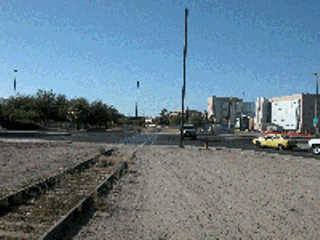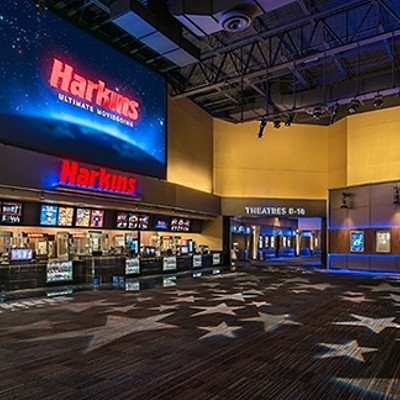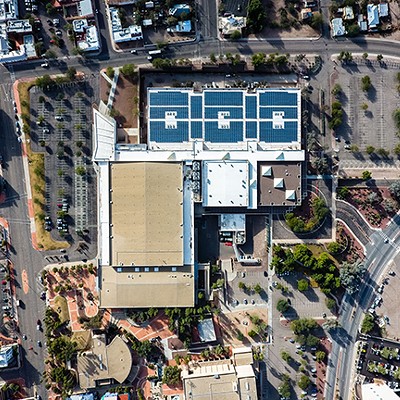Conceived and approved several years ago, the idea crystallized in 2002 as a 40-foot landscaped pedestrian/bicycle path along the abandoned El Paso and Southwestern railroad right of way just east of Interstate 10. The trail was intended to run more than two miles from an old railroad roundhouse south of 22nd Street to Oury Park in Barrio Anita, near Speedway Boulevard.
Proponents of the project saw many advantages, including keeping the historic train route intact with informational signs about the various neighborhoods along the trail. In addition, the path would be one short segment in a comprehensive trail system which could one day may encircle Tucson.
Steve Anderson, a planner with the Pima County Parks and Recreation Department, says the railroad greenway is a key component of this overall proposal.
By cutting through downtown and south Tucson, Anderson says, the trail can link up with Julian Wash, which runs east to the Houghton Greenway. From there, it would go north to Pantano Wash, Rillito Creek, and back to the Santa Cruz River.
While Anderson and many neighborhood groups along the railroad route supported the idea, city of Tucson staff members had questions. First, they wanted to know how the cash-strapped municipality would pay for it. Then, they wanted to determine how the proposal could be broken into segments for implementation.
Since the city owns the vacant railroad corridor through the Barrio Viejo neighborhood between 22nd Street and Cushing Street, staff members decided to apply for $500,000 of federal grant money next month to build this two-thirds-of-a mile section. While that step was generally applauded by supporters of the project, another recommendation by city staff members has drawn loud criticisms.
Today, the abandoned railbed north of Cushing Street crosses through empty land. But very big plans have been made for this thin strip of property: It is not only the eastern end of the University of Arizona's Science Center Rio Nuevo project, but is also the site of a planned, privately managed, huge community arena (See "Arena Agenda," Jan. 8, 2004). In addition, a civic plaza and parking garage are slated to potentially occupy some of the space.
Since the greenway concept collides head-on with the anticipated development north of Cushing Street, city staff members suggested the trail instead exit the railroad route and turn west to the Santa Cruz River.
"The greenway concept isn't agreeable with the Rio Nuevo buildings," says Melissa Antol, a planner with the city.
Anderson disagrees. He thinks by diverting the trail to the river, one primary purpose--preserving the old railroad corridor--is defeated. As an alternative, Anderson hopes the city staff is open to options.
"It can be integrated into the (building) features of Rio Nuevo and would be a tremendous complement to them," he says. "Why not link the neighbors with Rio Nuevo (through the greenway)? It's done all over the United States like that."
Barrio Viejo resident Dayton Fandray concurs with that conclusion, while calling the entire process frustrating.
"We need a little green space downtown, not just clumps of buildings," he says. "But I get the feeling the city staff is afraid if they require the greenway to run through the Rio Nuevo property, it might scare away some potential developers."
Acknowledging the possible conflict between proposed buildings and planned greenway, Assistant City Manager Karen Thoreson hasn't shut the door on continuing the trail north of Cushing Street, particularly since the physical requirements for the arena won't be known for several more months.
"The (building) footprints for the arena and Science Center will define that space," she says. "If they have to go where the rail line is, they have to go there.
"I'm willing to look at all options," she says, "but I absolutely won't commit to any one of them."
Even if the Cushing to Congress Street greenway conflict can be resolved, development of the project farther north is also problematic. In places, only a 10 foot wide strip of land is publicly owned, and new private development has been discussed for some of the remaining vacant property.
Anderson calls those hurdles "challenges," and emphatically believes the project north of Congress is doable. He adds that his agency has overcome more serious obstacles on other local trail projects.
Meanwhile, city staff members are uncertain if residents living near the proposed project will support an application for funding only the first section of the trail without a simultaneous commitment to eventually pursue the entire length of the greenway. City representatives haven't spoken to these groups in several months, but they plan to attend various neighborhood association meetings this summer to gather information on the topic.
Pedro Gonzales, president of the Barrio Viejo association, isn't certain what the reception will be at his neighborhood's gathering.
"People are really upset (with the city staff)" he says. "They've ignored us for some time now and totally disrespect us. So I don't know what will happen."
Thoreson says she hopes everyone can work together on the first phase of the project, but Barrio Viejo resident Fandray says he isn't confident that will happen.
"I get the idea the city staff thinks this is a nuisance instead of an asset," he says of the greenway proposal.
City planner Janice Miller says, "We are really, really frustrated (with the process), but we're not trying to kill the project."













